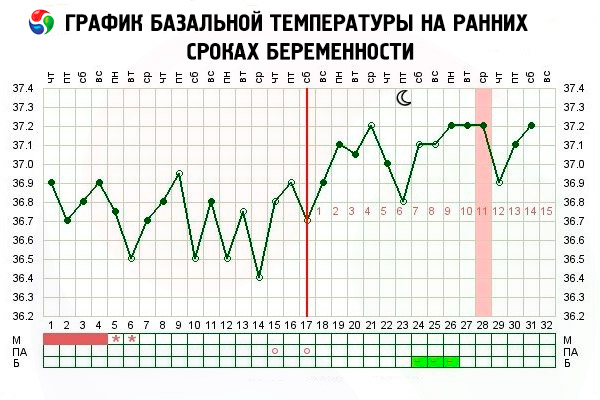Medical expert of the article
New publications
Basal temperature in early pregnancy
Last reviewed: 04.07.2025

All iLive content is medically reviewed or fact checked to ensure as much factual accuracy as possible.
We have strict sourcing guidelines and only link to reputable media sites, academic research institutions and, whenever possible, medically peer reviewed studies. Note that the numbers in parentheses ([1], [2], etc.) are clickable links to these studies.
If you feel that any of our content is inaccurate, out-of-date, or otherwise questionable, please select it and press Ctrl + Enter.

When the human body is maximally relaxed and is in absolute rest, its temperature regime is maintained solely by the energy released by the continuously functioning system of internal organs. The body muscles in this case are resting and do not participate in the process. Body temperature measured after a long rest is called basal. The ideal time to measure it is immediately after you open your eyes and have not yet gotten out of bed, in short - have not performed any unnecessary actions, have not even talked. Measurements are taken in the oral cavity, vagina, anus - in the same place convenient for a woman.
For women planning to become mothers in the near future, regular monitoring of changes in this indicator and recording its values will help track the onset of ovulation and the moment of conception, which will no longer be a secret for them. Tracked basal temperature during early pregnancy will help control your condition, detect its changes and even prevent spontaneous abortion.
This activity is a good way to calm down and make sure that everything is going according to plan. However, there is no need to worry about the decrease in indicators right away, there are enough modern methods to confirm or dispel the doubts of the expectant mother in time.
Basal Temperature Chart in Early Pregnancy
Temperature values measured once are absolutely not informative. Observations can be used for diagnostics only if they are done correctly, daily, recording the readings and noting the factors that influence the change in the indicators. This can be any event that happened the day before - a ski trip, a feast, stress, a viral infection, sexual intercourse, etc.

Ideally, you should start measuring your temperature while you are planning your pregnancy, especially for women who have already had a miscarriage. Daily measurements are taken from the very beginning of your monthly cycle after waking up in the morning, using the same thermometer all the time. The readings are recorded in a notebook in the form of a table. It is very convenient and clear to use a temperature chart.
It is not advisable to measure temperature during the day or in the evening, since the tests should be preceded by a full rest of at least four to six hours. It is really possible to get adequate readings only after a night's rest.
For women who have started tracking their basal temperature while planning for pregnancy, a reading of 37.2℃ will indicate the beginning of ovulation, meaning they can begin to conceive.
In cases where pregnancy has already occurred, it is recommended to start plotting a basal temperature chart in the early stages of pregnancy. This advice should especially not be neglected by those who already have a history of spontaneous abortions. The efforts made will be rewarded. Changes in the temperature chart in the first months of gestation can warn of a dangerous situation (threat of miscarriage, the onset of an inflammatory process) even before noticeable symptoms appear and promptly take the necessary actions by seeking help from a doctor. Such observations are especially valuable in diagnosing luteal phase insufficiency.
What is basal temperature in early pregnancy?
There is absolutely no point in taking measurements during the day, these data are absolutely not indicative. Depending on various factors - physical, mental and nervous activity, even hot tea with a sandwich and an emotional phone call, the basal temperature during the day and evening in the early stages of pregnancy changes repeatedly, and it is unrealistic to ensure complete rest for several hours during the day.
The normal basal temperature in the early stages of pregnancy is from 37.1℃ to 37.3℃. It should reach some value from this range by the time the egg leaves the ovary and, if fertilization has occurred, the temperature at the beginning of pregnancy will no longer decrease.
This phenomenon is explained by the increase in the content of the pregnancy hormone progesterone in the body, the most important one, without which the development of the embryo is impossible in principle. The method of plotting a basal temperature chart is used in the early stages of pregnancy, since the temperature indicators can be used to orient oneself with a fairly high probability about the presence of the required amount of progesterone.
Each woman has an individual basal temperature indicator, it may slightly exceed the normal range, but a deviation of 0.8℃ should already be a warning sign.
For an expectant mother, a basal temperature of 37.0℃ in the early stages is considered the lower limit of the norm. If such indicators persist for three to five measurements, and you cannot remember any factors that provoke such a situation, for example, strong anxiety, unusual physical stress, regular lack of sleep, then this is a reason to consult a doctor. There is no reason for great concern yet, such an indicator may well be your individual norm, however, there is a high probability of hormonal changes beginning, which are dangerous.
A basal temperature of 36.9℃ or less in the early stages is considered low. It may indicate trouble with a high probability, and the most normal temperature for a healthy person of 36.6℃ is already a reason to run to the doctor, since there is a high risk of fetal death. A low basal temperature in the early stages of pregnancy indicates the emergence of a danger of its termination. A decrease in temperature may be a symptom of a preclinical form of threatened spontaneous termination of pregnancy, even if no other signs of trouble are observed in the pregnant woman. Timely treatment of hormonal imbalance can prevent this event. Data for monitoring the effectiveness of hormonal treatment for the threat of embryo death and spontaneous abortion can also be obtained by analyzing basal temperature indicators.
However, it is quite possible that low temperature readings in the first trimester (36.6℃ or 36.7℃) may be a normal variant, especially if the woman had a low normal temperature before pregnancy. A basal temperature chart plotted during pregnancy planning can resolve this issue.
You can resolve your doubts by contacting a doctor and having your blood tested for hCG, which will determine whether it corresponds to the gestation period. Ultrasound diagnostics will also be informative. The presence of a heartbeat in the embryo is an indisputable symptom of pregnancy progress even at a low basal temperature.
When temperature readings are higher than normal, this condition can be caused by gynecological inflammatory pathologies, sometimes such a symptom accompanies tubal or ovarian pregnancy. Small deviations can also be a normal variant, however, it will not hurt to get checked, visit your local gynecologist if the basal temperature in the early stages is 37.4℃ and higher.
Is it necessary to plot a temperature chart and for how long?
Doctors' opinions on this matter differ. Many do not recommend doing this, because women, noticing temperature fluctuations beyond the norm, are very upset and worried, and the reliability of the results of such studies is considered low. Modern medicine has methods that are quite effective and simple for confirming the fact of pregnancy progression.
However, everyone knows that early pregnancy is the period when spontaneous abortion most often occurs. And I really want to find a way to prevent this and recognize the pathology in time, especially if it has happened in the past. It is also a known fact that the basal temperature during a miscarriage in the early stages, or rather when it is threatened, decreases. So monitoring changes in temperature indicators still allows you to control the process of pregnancy in the early stages and consult a doctor in time. It makes sense to plot a temperature chart only in the first trimester, then a temperature of 36.9 ℃ and below becomes an absolutely normal phenomenon and no longer has clinical significance.
In addition, you should not rely only on the temperature chart. Firstly, even the “correct” basal temperature does not guarantee a successful pregnancy, and secondly, trouble usually manifests itself in some other way. For example, a sudden cessation of early toxicosis, pain above the pubis or in the perineum, discharge with blood impurities, both bright and clotted, brown, should cause concern.
Therefore, plotting a basal temperature chart must be combined with other diagnostic measures included in the pregnancy management plan.

